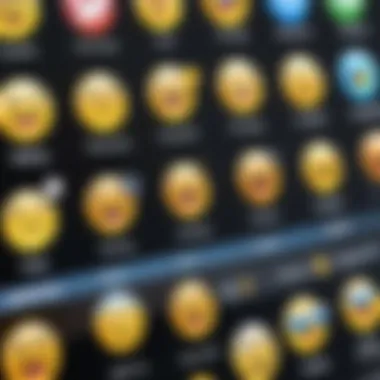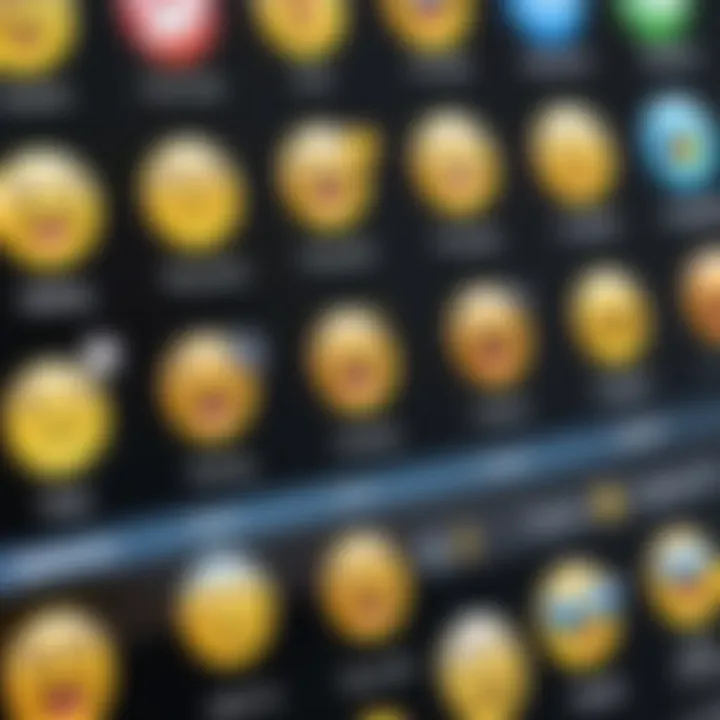How to Access and Use Special Emojis Effectively


Intro
In today's digital world, emojis have become a lexicon of their own, shaping conversations and bringing a splash of emotion to our messages. From sharing laughter to expressing frustration, these little icons convey complex emotions instantly. However, acquiring unique or special emojis requires more than tapping a screen. It’s about exploring the depths of available resources, which can enrich both personal and professional communication.
Why Special Emojis Matter
Emojis aren't just for fun; they add layers of meaning to text that plain words might fail to convey. In professional settings, the right emoji can soften a message or convey humor without derailing tone. For social media enthusiasts, unique emojis add flair and differentiate one’s online persona. As we navigate through this guide, you’ll see that acquiring special emojis is not only about finding them; it’s about effectively using them.
This article will peel back the layers of emoji acquisition, outlining how to access these visual tools. We'll explore various platforms—think iOS, Android, Microsoft Teams, and social media apps—to get you well-equipped. You’ll also discover practical advice tailored to your needs, so you can deliver your digital message with style.
Here’s what we’ll delve into:
- Where to find special emojis
- How to integrate them into your communication
- The impact of custom emojis in branding and personal identity
- An unveiling of tools and resources for emoji creation
So, buckle up and get ready to explore the expansive universe of emojis and their crucial role in effective communication without sounding overly dramatic. Let’s jump into the details!
The Role of Emojis in Digital Communication
In the rapidly evolving landscape of digital interaction, emojis have carved out a crucial role, transcending mere decoration of text. They serve as visual aids that enhance the clarification of feelings, intentions, and context in our communications. This section explores how emojis contribute to the richness of digital dialogues, shaping not just how we express ourselves but also how we connect with one another in virtual spaces.
Understanding Emojis
Emojis, those small pictorial symbols, act like a bridge between spoken and written communication. Originally designed for mobile phones, they have become a universal language of sorts. When words might fail, a simple smiley face or a thumbs-up can convey approval or happiness instantly. This is especially notable in groups, where textual messages can easily lead to misinterpretation. Emojis provide a shortcut to feelings, cutting through the ambiguity inherent in plain text. They help in expressing nuances that might be lost in translation, especially across different cultures.
For instance, consider a text which simply says, "I got your message." Without the right emotional cue, that can come across as indifferent. Add an emoji, and suddenly it’s transformed. The same sentence complemented by a smiling emoji turns an otherwise neutral statement into one of warmth and acknowledgement.
Emojis as a Language
In many ways, emojis can be viewed as an evolving language of their own. Just like dialects, different cultures adapt and modify their use of emojis to resonate with local sentiments and customs. For example, the Japanese use emojis far more generically compared to their Western counterparts, often embedding them in everyday conversation. This variableness reflects regional expressions and social nuances, emphasizing how emojis can alter the tone and meaning of a message based on context.
This adaptability can also influence the effectiveness of communication. Emojis can clarify what tone you want to communicate, whether it's playful, sarcastic, or sincere. While some may argue emojis add unnecessary clutter to conversations, others see them as an essential tool that enriches communication.
As we delve deeper into the realm of special emojis, we focus on how these symbols evolve, how they're crafted, and their specific applications across various platforms. With countless new emojis being introduced, it’s intriguing to consider what this means for the future of communication. They have not only changed how we articulate ourselves but also how we perceive each other in the digital sphere.
Emojis are more than mere images; they encapsulate emotion and context that words sometimes lack.
Defining Special Emojis
In the context of digital communication, understanding special emojis becomes paramount. Emojis serve not just as decorative elements but as powerful tools to convey emotions, tone, and even context in a sometimes drab textual landscape. When we talk about special emojis, we refer to those that go beyond the standard set found on most devices. These include emojis that represent specific cultural icons, new symbols that have emerged in response to popular trends, or even entirely custom-made graphics that reflect personal uniqueness. The significance of defining special emojis lies in their ability to enhance digital discourse, making conversations richer and more relatable.
What Constitutes a Special Emoji?
Special emojis can take many forms. They might be:
- Culturally significant representations: For instance, the emoji of a taco is relatable in TexMex culture, but might not carry the same weight in other culinary contexts.
- Trending symbols: Think of emojis that pop up in response to global events, like a virus emoji during a health crisis. Such images evolve based on cultural zeitgeist and societal needs.
- Customized designs: Many platforms, such as Bitmoji, allow users to create personalized versions of emojis that look like them or represent their style, giving voice to individual expression in the digital space.
Defining what makes an emoji special isn't just about visual appeal; it involves an understanding of its place within the broader context of communication. A custom emoji a user designs can carry a narrative, evoke laughter, or even symbolize solidarity. Therefore, special emojis can be valuable assets in crafting a unique digital persona.
Common Platforms for Special Emojis
The digital realm boasts various platforms where special emojis can be sourced. Here are a few of the key players:
- Social Media Platforms: Applications like Facebook and Twitter regularly update their emoji sets, often incorporating trending symbols. These platforms often introduce limited-time emojis as well.
- Messaging Apps: WhatsApp and Telegram allow for both standard emojis and special ones, often derived from user-generated content as stickers, allowing for a more customized communicative experience.
- Custom Emoji Apps: Apps like Bitmoji or Gboard’s Emoji Kitchen give users the freedom to create their own emojis, mixing and matching elements to suit their preferences.
- Gaming Platforms: With the rise of online gaming, platforms like Discord and Twitch have rolled out specialized emojis that players can use to express themselves during gameplay, fostering a sense of community.
These platforms highlight the flexibility and sheer variety of special emojis, showing their evolutionary path in alignment with technological advancements and user preferences. By recognizing where these special emojis exist, one can better navigate their usage and integrate them into personal communication effectively.
Acquiring Special Emojis: General Approaches
In today’s fast-paced digital world, special emojis have transitioned from mere embellishments to significant elements of online communication. Their importance lies not just in making conversations visually appealing but also in conveying emotions and nuances that text alone often struggles to express. The ways to acquire these unique symbols vary across platforms and devices, making it essential for users to navigate these options effectively.


Accessing special emojis requires an understanding of the methods available, as well as an appreciation of the advantages that come with utilizing them. For instance, adding a unique emoji can help personalize a message, making it feel more intimate. Additionally, in professional contexts such as marketing or branding, using special emojis can enhance engagement and create a memorable identity.
While many people may simply rely on what their devices provide, the world of emoji acquisition is rich with options worth exploring. Below are two significant approaches—emoji apps and keyboards, and third-party integrations—that can help in obtaining and utilizing special emojis.
Emoji Apps and Keyboards
Using dedicated emoji apps and keyboards has become increasingly popular among users looking for a broader range of options. Various applications are designed specifically to offer an extensive selection of emojis, frequently updated to reflect current trends and cultural sentiments. Some of these apps allow users to search for emojis based on themes or emotions, making it easier to express oneself appropriately in different contexts.
For example, apps like Emojipedia or Bitmoji provide a wealth of choices beyond what standard keyboards offer. Integrating these apps with existing messaging platforms can transform how users send texts, making conversations vibrant and engaging. Simply download the app, follow a few setup steps to enable it on your device's keyboard, and you’re good to go!
Beyond additional options, these apps often include customization features, allowing users to create emojis that mirror their personalities or intensify their expressions. With this individual flair, text exchanges transform from standard messages into memorable interactions.
Third-Party Integrations
Another approach to accessing special emojis is through third-party integrations mized for platforms like Slack, Discord, or WhatsApp. These integrations often facilitate the use of specific libraries of emojis tailored to particular communities or themes.
For instance, a team using Slack can create their own set of emojis. By doing this, they can reinforce workplace culture, making interactions feel closer and more friendly. This communal aspect adds a layer of connection that generic emojis cannot provide.
With tools like Giphy or Tenor, users can also explore animated emojis—those lively GIFs that capture a moment with flair. These integrations open doors to a creatively enriched communication style, making mundane chats lively and memorable.
To wrap it up, acquiring special emojis isn’t just about having a variety at your fingertips; it’s about enhancing the way we communicate in our digital age. Whether through emoji apps and keyboards or leveraging third-party integrations, users have a plethora of choices to express themselves more profoundly. The journey to discovering and utilizing these emojis reflects an ever-evolving landscape—one that deserves exploration and appreciation.
"Emojis are not just fun; they are a bridge to deeper understanding in an increasingly packed digital world."
As technology continues to advance, understanding how to harness these tools becomes ever more integral to effective communication.
Platform-Specific Methods for Special Emojis
In a world where emoji usage has permeated digital conversations, understanding the various platform-specific methods for acquiring special emojis becomes crucial. Whether you're a social media maestro or a texting enthusiast, having access to unique emojis enhances your ability to express emotions, convey nuanced meanings, and add flair to your messages. The beauty of emojis is that they can transcend language barriers, yet the way in which we access special emojis can differ vastly from one platform to another. Therefore, it’s essential to explore these methods to enrich your digital vernacular.
Special Emojis on Mobile Devices
Mobile devices, such as smartphones and tablets, are where the majority of emoji interactions take place. With apps like WhatsApp, Instagram, and Snapchat constantly evolving, platforms often bring out new emojis that become favorites among users. For instance, both iOS and Android operating systems regularly update their emoji libraries.
To tap into these special emojis on mobile devices, consider the following methods:
- System Updates: Regularly updating your phone ensures access to the latest collection of emojis. Apple and Google frequently add new characters to their emoji sets in updates, so missing out on these could mean losing out on fresh expressions.
- Third-Party Keyboard Apps: Applications like Bitmoji or Gboard allow users to integrate their extensive custom emoji collections. With these tools, users can find and use emojis ranging from playful to professional.
- In-App Emojis: Many messaging and social media apps have their own exclusive emojis. For example, Snapchat features Lenses that allow for a fun and interactive emoji experience. Therefore, exploring in-app offerings is crucial.
Accessing Emojis on Desktop Applications
Even though mobile devices dominate emoji usage, desktop applications also provide valuable methods for accessing special emojis. The desktop environment can often be more conducive for professional communication while still benefiting from unique emoji usage.
Here are some insights for obtaining special emojis on desktop platforms:
- Emoji Keyboard Shortcuts: Both Windows and Mac computers have built-in shortcuts to access emoji panels. On a Windows OS, pressing (dot) opens an emoji picker, while on Mac, brings up the emoji viewer.
- Dedicated Browser Extensions: For web-based communication tools like Slack or Discord, utilizing plugins or browser extensions can provide enhanced access to emojis not included in their native libraries. Some of these extensions even allow for customization of emojis.
- Operating System Emojis: Similar to mobile, both macOS and Windows have integrated emoji options that are regularly updated. Keeping your system updated enables access to the latest emoji collections directly from your OS panel, allowing for seamless integration in communication software.
"Special emojis are more than just decorative additions; they are a vital part of understanding the emotions and subtleties in our digital conversations."
In the ever-evolving landscape of digital communication, utilizing specialized methods tailored to individual platforms can set your messaging apart. With special emojis at your fingertips, every text can be a little more expressive, a bit more colorful, and considerably more engaging.
Customizing Special Emojis
In the digital landscape we're navigating today, customizing special emojis holds a significant place. Emojis have evolved from mere visual embellishments to essential tools for expressing our emotions and ideas. Customization allows individuals to bring their personal touch into communication, making messages more relatable and unique. When you create your own emojis or modify existing ones, you tap into a vein of creativity that not only colors the way you converse but also infuses your personality into digital interactions.
Designing Your Own Emojis
The process of designing your own emojis can seem daunting, but it's an adventure worth embarking on. With the right mindset, you can turn a simple idea into an expressive icon that resonates with you. Here are a few considerations and benefits of creating custom emojis:


- Personal Expression: Every design you create can embody a part of yourself, from inside jokes to your hobbies.
- Enhancing Communication: A well-thought-out design can convey complex emotions or concepts more efficiently than words alone.
- Creativity and Fun: Designing emojis can be a playful outlet for creativity, providing a satisfying endeavor that fosters engagement with your audience.
Creating one’s emoji typically involves using graphic design software or specialized apps. Here’s a typical workflow to consider:
- Brainstorm Ideas: Think about the emotions or messages you want to convey. Sketch them out on paper.
- Digital Tools: Use programs like Adobe Illustrator or free alternatives like GIMP. Drawing apps on mobile devices also work great, if you're on the go.
- Color and Style: Choose colors that resonate with your message or brand. Each color can evoke different emotions.
- Cute or Cool: Decide on an aesthetic—should your emoji be cute, political, or maybe even abstract?
- Test and Share: Once designed, test your emoji by using it in various conversations to gauge its effectiveness.
By following these steps, you’ll not only design an emoji, but you'll craft a personal piece of your digital identity.
Using Emoji Generators
For those who might feel that design isn't their strong suit, there’s a plethora of emoji generators available that can ease the process. These generators can help you create visually appealing emojis with just a few clicks. Here are some popular tools that can help:
- Bitmoji: A fun platform where users can create personalized cartoon avatars that can be shared across various messaging platforms.
- Emoji Maker: Websites like Emoji Maker allow you to combine elements to form unique emojis, ideal if you’re looking for customization without heavy design work.
- Gboard's Emoji Kitchen: A feature in Google’s keyboard app that merges existing emojis to create new, fun variations on the fly.
The advantages of using these generators include:
- User-Friendly Interface: Most tools are designed to be straightforward, allowing for easy navigation.
- Immediate Results: Quickly generate emojis without the hassle of professional design skills.
- Shareability: Easily integrate these creations into messages or social media posts.
"The ability to customize emojis has opened new avenues for expression, defining interactions in a more personalized manner."
Integrating Special Emojis in Communication
In today's fast-paced digital world, integrating special emojis into communication has become increasingly relevant. Emojis are no longer mere decorative symbols; they have evolved into key components of conveying emotions, adding nuance, and enhancing the clarity of messages. The incorporation of special emojis—from unique designs to culturally relevant symbols—can greatly enrich the way individuals express themselves across various platforms.
Special emojis serve multiple purposes. Firstly, they act as visual cues, enabling the recipient to grasp the sender's intent more effectively. Context often gets lost in text-based interactions. Emojis can bridge that gap, providing clarity to nuanced statements which might otherwise be misinterpreted. For instance, a simple message that states, "I’ll be late," can feel a lot different when accompanied by a frowning emoji versus a serene emoji. This disparity clearly illustrates how emojis inject emotion into otherwise flat communication.
Another vital aspect is how emojis promote engagement and connection. In a world where digital conversations often feel impersonal, special emojis offer a way to inject personality into these interactions. Emojis facilitate a shared language, breaking down barriers that may exist due to cultural differences or language proficiency. When people see an emoji they relate to—like a heart emoji from a trusted friend—they feel acknowledged, revealing a deeper emotional connection.
However, the integration of special emojis demands consideration. It’s essential to remain mindful of context and audience. Emojis can vary greatly in interpretation based on cultural backgrounds. For example, while a thumbs-up emoji generally signifies agreement in many cultures, it might carry a different connotation in specific cultures, potentially causing misunderstandings. Therefore, knowing your audience and how they use emojis is crucial to maintaining effective communication.
"Emojis are not just frivolous doodles; they’re a sophisticated part of our modern correspondence that can steer the emotional direction of dialogue."
In summary, integrating special emojis into communication is an art that, when applied thoughtfully, can significantly enhance both personal and professional exchanges. Their ability to convey emotions, foster connection, and clarify meaning underscores the increasingly important role that these tiny images play in shaping human interaction.
Enhancing Text Messages
Utilizing special emojis in text messages can dramatically elevate the quality of communication. The beauty of emojis lies in their universality; they can communicate feelings that words sometimes fail to express. When someone receives a text laden with special emojis, it often comes across as more engaging and less monotonous. In this way, they can draw attention to important points in messages and provide visual relief in long-winded conversations.
Some specific benefits include:
- Expressiveness: Emojis breathe life into messages, helping convey tone, mood, and emphasis. A sad face emoji can convey empathy better than words alone.
- Conciseness: Emojis replace words, making messages shorter while retaining meaning. Instead of saying, "I’m really excited!", one might simply send 🎉.
- Identity: Using special emojis adds a personal touch to texts, allowing individuals to express their unique styles or affiliations. For example, a baseball fan might use team-specific emojis to showcase their passion.
Using Emojis for Social Media
Social media platforms thrive on brevity and visual content, making the adoption of special emojis increasingly beneficial in these environments. They play a vital role in grabbing attention amid a sea of posts. Emojis can enhance captions, create hashtags that are more visually appealing, and stimulate interaction through comments and reactions.
With attention spans shorter than ever, here are some effective uses for emojis in social media:
- Engagement: Posts enriched with relevant emojis often see higher levels of engagement, as visuals draw user attention and resonate emotionally.
- Branding: Companies can use special emojis aligned with their brand identity. A playful image can enhance a fun brand, while a more sophisticated emoji might suit a luxury brand.
- Trends and Culture: Staying current includes recognizing popular emojis that align with trending events or cultural moments, aiding relatability and providing a connection to wider conversations.
Cultural and Emotional Implications of Emojis
The discussion of emojis extends far beyond their decorative purpose. Emojis act as a bridge in digital conversations, carrying nuanced meanings that can alter how messages are interpreted. Understanding the cultural and emotional implications of emojis can profoundly influence communication, making it more effective and enriched. This section will delve into two significant aspects: how emojis vary across cultures and their emotional impact on the interaction.
Emojis Across Different Cultures
Emojis are not one-size-fits-all; their meanings can fluctuate drastically from one culture to another. For instance, the thumbs-up emoji is a friendly gesture in many Western cultures, often symbolizing approval or agreement. However, in some parts of the Middle East and Asia, it can be considered highly offensive.


When communicating with individuals from diverse backgrounds, it’s crucial to consider these cultural intricacies. A smiley face may be perceived as warm and welcoming in North America but might come off as insincere or overly casual in more formal cultures like Japan. This difference in interpretation can lead to miscommunication.
Furthermore, in regions where certain colors or symbols have rich cultural significance, an emoji's color or form can evoke different feelings. For example, red can symbolize love in many contexts but is viewed as a color of mourning in some Asian cultures. Recognizing these variations can help ensure that an emoji used in a conversation conveys the intended message appropriately—including awareness of culturally sensitive topics.
Emotional Impact of Emojis on Communication
Emojis hold a unique power in influencing the emotions of both sender and receiver in digital exchanges. They can add layers of meaning that plain text lacks. A simple message can seem warmer with a heart emoji or more serious with a frowning face. This ability to convey tone is crucial since text can often lead to misunderstandings about intent.
- Expressive Influence: Emojis can help express feelings more clearly. When someone sends a message with a smile, it can soften the message, indicating friendliness. Conversely, using emojis can also indicate sarcasm or teasing—like the winking face emoji, which suggests playfulness.
- Emotional Bonding: Regularly using emojis can forge a sense of connection, especially in long-distance relationships. They work like little emotional cues, maintaining intimacy through digital means. When words fail, emojis can fill the gap with laughter, love, or reassurance.
- Mood Enhancements: Research indicates that the inclusion of emojis can influence the mood of the conversation. A message peppered with joyful emojis can elevate the overall sentiment of a chat, imbuing it with positivity and joy.
"Emojis do not merely decorate our language; they often replace it. Understanding the emotional weight they carry adds depth to our communication."
Ultimately, the cultural and emotional implications of emojis help us navigate digital conversations more adeptly, making them relevant across various demographics. When employed judiciously, they can enhance communication, foster understanding, and create connections that span across cultural divides.
Legal and Ethical Considerations
The advent of digital communication has seen emojis become an integral part of how we convey emotions and thoughts. However, as the usage of these symbols grows, so too do the legal and ethical implications surrounding them. In this section, we will bring clarity to the often-overlooked aspects of acquiring special emojis. This exploration reveals how copyright issues and privacy concerns can impact individuals and businesses alike. Understanding these elements is crucial for anyone wanting to navigate the emoji landscape responsibly and effectively.
Copyright Issues in Custom Emojis
When delving into custom emojis, the topic of copyright cannot be dismissed. Just as with artwork or music, the unique designs of emojis fall under intellectual property laws. Though anyone can create their own emojis, the moment they decide to sell or distribute them, they could tread on murky waters if those designs resemble existing ones.
- Originality: To avoid copyright issues, creativity should be at the forefront. Developing truly unique designs, rather than merely tweaking existing emojis is paramount.
- Licensing Agreements: For those wishing to use popular emoji designs, seeking licensing agreements could provide a legal path forward. This ensures that the original creators are acknowledged and compensated for their work.
- Community Sharing: Platforms like Reddit and Facebook often feature custom emoji collections that users can share freely. However, one must still respect the stipulations set by the original creators; simply put, just because something is available doesn't mean it's free to use without consequences.
A relevant point to remember is that even humor can turn sour if the original creators perceive misuse. Beneath the surface of friendly exchanges can lie serious legal action, especially when high-profile companies are involved.
"The line between inspiration and infringement can often be blurry in the world of custom emoji creation."
Privacy Concerns with Emoji Usage
With the rise of special emojis, we must also confront their implications for privacy. Many applications and platforms track user interactions with emojis. This may not just involve how emojis are used but also involves the data that underpins their usage.
- Data Collection: When emojis are utilized on certain platforms, especially third-party applications, users might unknowingly consent to data collection regarding their emoji usage. This data can be used to create user profiles, allowing for tailored advertisements or even selling information without proper consent.
- Communication Security: In a world where data breaches are all too common, understanding how emojis fit into communication security is critical. Using emojis in messages does not inherently lead to risks, but when vulnerable platforms store communication data, it poses a threat. Users must be vigilant about which platforms they use for their communications to safeguard against unauthorized access.
- Public Perception: Lastly, the perception of how emojis reflect thoughts or feelings is another layer in this conversation. Misusing emojis or using them inappropriately has led to conflicts in personal and professional relationships. Therefore, the ethical handling of emoji communication is not just a personal concern; it can also impact reputations and social standing.
As digital interactions increasingly depend on visual language, being conscious of the legal and ethical landscape surrounding emojis is vital. In the rapidly evolving realm of technology, staying informed helps us use emojis in a responsible yet expressive way.
Future of Emojis in Digital Communication
The evolution of communication in the digital world is a fascinating narrative. With each passing year, emojis have transformed from a mere set of icons to a significant form of expression. The future of emojis in digital communication is not just relevant; it's vital. As technology advances, people's need for concise and efficient expression grows stronger. Emojis cater to this need by packing complex emotions and ideas into tiny visuals. This not only enhances clarity but also adds a flair of creativity to our exchanges.
Considering the impact of globalization, emojis also create a universal language that transcends linguistic barriers. As cultures collide, the ability to communicate with visual elements becomes paramount. This not only fosters understanding but opens new avenues for interactions in diverse digital spaces.
As we uncover fertile ground for innovation, trends will continue to evolve, ultimately reshaping our discussions and the tools we employ.
Emerging Trends in Emoji Usage
With technology always on the move, it’s no surprise that certain trends are in the pipeline, waiting to evolve the emoji landscape. One significant trend is the rise of contextual and situational emojis. Rather than a one-size-fits-all approach, emojis will adapt to the context in which they're used. Imagine a world where you can have emojis that change expression based on the tone of your conversation! This precision will allow for more nuanced communication.
Furthermore, expecting trends like augmented reality (AR) integration is not far-fetched. Picture this: while communicating through video calls, users could literally project emojis around their environment. Such immersive experiences would deepen engagement and add a new dimension to digital relationships.
Also noteworthy is the growing embrace of inclusivity. Companies are paying keen attention to representing diverse cultures, genders, and identities in their emoji sets. This shift signifies a broader acceptance and awareness of social issues, illustrating how emojis can be a tool for change.
Potential Innovations in Emoji Technology
The horizon is bursting with possibilities as innovations loom on the emoji front. One exciting prospect is the development of advanced algorithms that could analyze the emotional tone of digital conversations in real-time, subsequently recommending emojis based on context and sentiment. This could revolutionize how we express ourselves online. Instead of trying to find the perfect emoji, an AI-driven assistant could suggest options that align closely with the mood of the discussion.
Alongside this, the advancement of customizable emojis, tailored to an individual’s unique preferences, is becoming increasingly feasible. Imagine creating your own emoji that encapsulates your personal style or inside jokes with friends. This level of personalization could enhance user engagement and make conversations feel more intimate.
Additionally, the union of emojis with Artificial Intelligence could spur new forms of expressions. AI may soon be capable of generating tailored emoji responses or even transforming the way emojis convey emotions by using machine learning to enhance their expressiveness.
Embracing the future means recognizing that emojis are no longer just a tool; they're a bridge connecting us to a broader narrative, one filled with emotion, cultural significance, and innovation.
By keeping an eye on these trends and innovations, tech-savvy individuals and early adopters can stay at the forefront of this evolving digital language.



